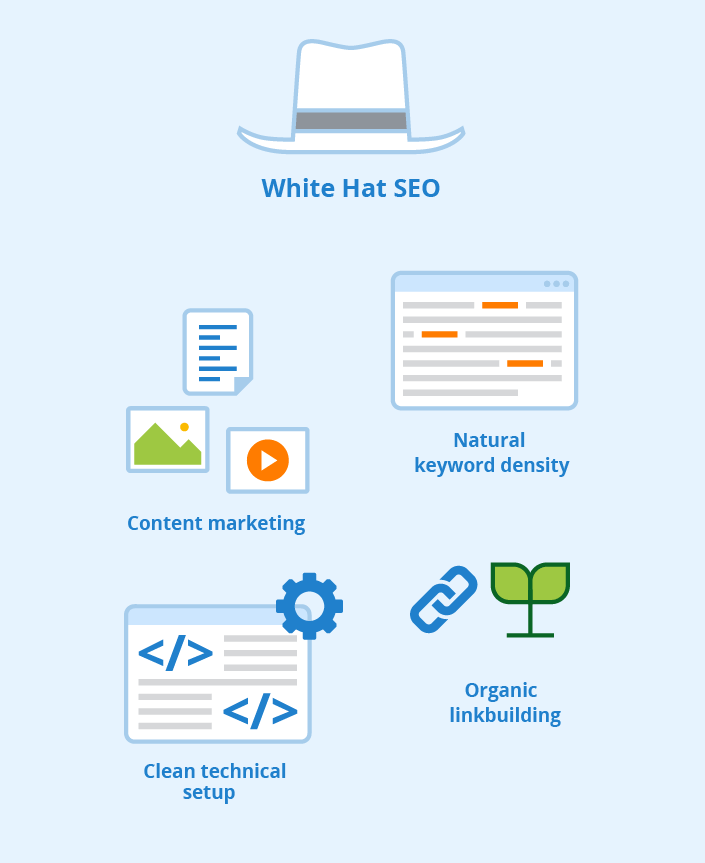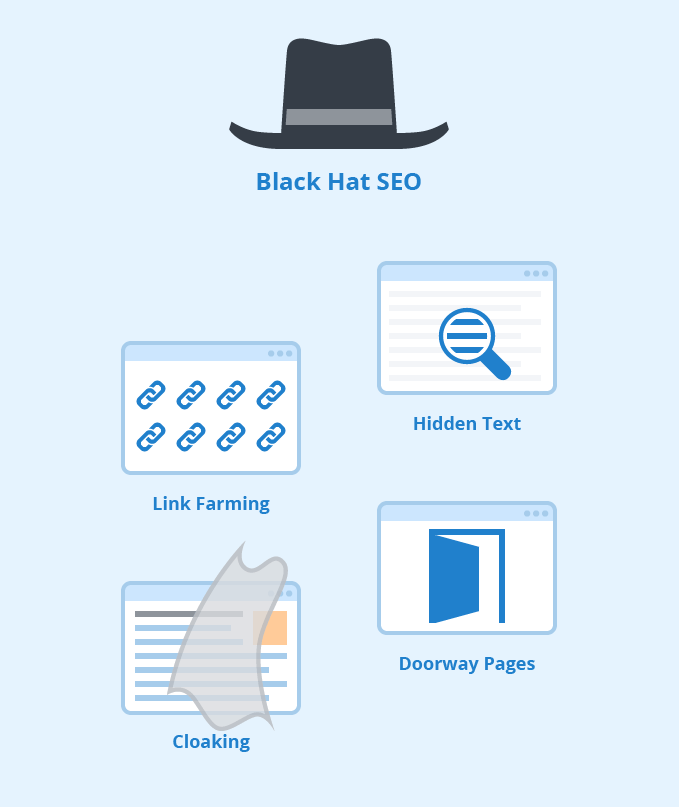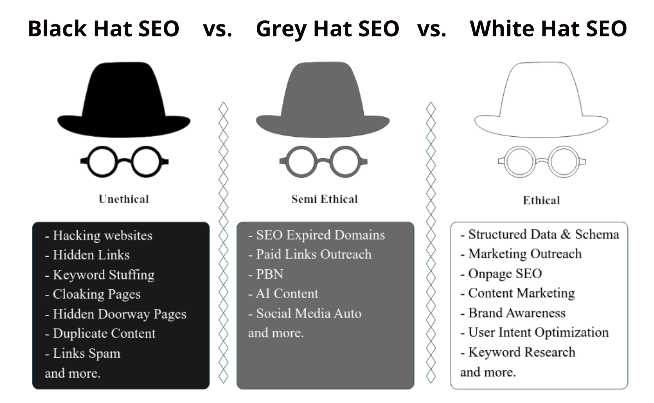
Backlinks are critical aspects of Search Engine Optimization (SEO) because they demonstrate to Google and other search engines that your website has authority. If you have high-authority websites linking to yours, all the better. Earning those backlinks is no easy task. You should have a backlink-building strategy in place as part of your overall SEO strategy. The challenge to building your backlink profile is that backlinks are intended to be earned naturally and not milled or purchased from link farms. Further, you may reach out to select websites to request a backlink, hoping for professional courtesy; however, many webmasters are now asking for fees to place your link on their site.
Taking money for backlinks is unprofessional and falls under black hat SEO practices, which brings up the discussion of what’s considered white hat, black hat, or grey hat SEO. The most significant differences between white hat and black hat SEO are that white hat SEO follows Google’s guidelines and improves user experience. In contrast, black hat SEO violates those guidelines and is typically done with disregard for human users. Grey hat SEO, as you’d expect, involves techniques that blur the lines and exist between white and black. Let’s break this down a bit more and then discuss the best way to build backlinks.
White Hat SEO
Given that the heroes of old westerns always wore white (while the villain wore black), it’s easy enough to define white hat SEO as the correct, ethical way to approach SEO. To be more specific, it’s SEO that follows Google’s SEO guidelines rather than trying to get around them or somehow trick Google into ranking your site rank higher.
Here are the three main principles of white hat SEO:
1. Follow Search Engine Guidelines
The most straightforward definition of white hat SEO is that it follows Google’s Search Essentials (formerly known as Google’s Webmaster Guidelines). Google publishes its rules for defining the proper way to optimize a website. There, you’ll find a high-level description of what’s ethical; however, all that can be summed to a simple guideline: Avoid using manipulation. SEO involves following the guidelines, not manipulating Google’s algorithm or circumventing the system.
2. Focus on Your Human Audience
While it’s true that a significant SEO goal is driving traffic to your website, Google’s priority is giving users the best possible experience, meaning search results should lead visitors to the content they are looking for. Further, that content should be rich and compelling.
Moreover, white hat SEO means employing techniques that benefit your site’s visitors. This is accomplished by such things as creating quality content, improving page load times, and streamlining site navigation. All these things will also lead to more backlinks over time.
3. Make a Long-Term Plan
White hat SEO strategies often take a little more time to implement and yield results than black hat strategies. Following Google’s guidelines takes more work but is far more successful at creating a positive user experience. The rewards come with knowing that white hat SEO techniques have a lasting impact that grows your traffic over time. As a result, you’ll see steady rankings for your chosen keywords.

Black Hat SEO
It almost goes without saying that black hat SEO is the opposite of white hat SEO. Black hat tactics often violate search engine guidelines. Google lists specific SEO strategies that you should avoid. Such tactics are often manipulative because they focus on manipulating Google’s algorithm to improve rankings rather than on user experience. Black hat SEO attempts to fool Google into thinking the website contains more value than it actually does.
Finally, black hat SEO attempts to skip the long-term execution and Return On Investment (ROI) of white hat SEO. These unethical strategies exploit loopholes in the algorithm. When they work, they produce quick, albeit short-lived, results. Black hat strategies risk losing rankings whenever Google updates its algorithm, which is why these results are short-lived.

Grey Hat SEO
Sometimes the lines between white hat and grey hat SEO are blurred. Grey hat is any SEO strategy that falls into this grey area. For example, rewriting an article that performed well is an example of grey hat SEO because the article doesn’t contain anything original.
Link building presents a complex challenge in adhering to white hat SEO criteria. Industry experts often disagree on what is considered white or grey hat link-building strategies. For instance, most experts agree that three-way or four-way link building is unethical. In these instances, one site links to a second site, the second site links to a third, and the third links back to the first site.
Yet, some feel that even guest blog posting is grey hat SEO, even though that’s a widely recommended practice. Google doesn’t state that writing articles for other websites is poor practice. If the content of the article contains multiple links to your website, you have definitely wandered into grey hat SEO. However, it’s acceptable to include a link to your website in your bio at the end of the article. Even then, some would argue grey hat, others would say white.

Let’s talk about link building in more detail and see how you can earn backlinks naturally and ethically.
Link Building
Link building is the SEO practice of acquiring hyperlinks, also called backlinks, that point back to your website. They are sometimes called inbound or external links. Link building can generate long-term returns because search engines like Google view backlinks as votes of confidence. Essentially, you vouch for another website by linking to it. For this reason, pages with many backlinks rank higher on the Search Engine Results Pages (SERPs). These rankings are further elevated when the backlinks come from respected, authoritative sites. In addition to improving SERPs results, quality backlinks can boost your site’s credibility, generate referral traffic to your website, and assist Google in finding any new pages you’ve published.
Ideally, websites that contain quality content will gain links and rankings naturally. Although natural link building takes time, many people try to speed up the process. In fact, buying links is becoming a common practice that doesn’t necessarily fall into the black hat or grey hat categories. Also, SEO companies offer what they call white hat link-building services; however, a service that generates links for money doesn’t qualify as white hat SEO. Before we get any deeper here, let’s discuss the difference between white and black hat link-building practices.
White Hat Link Building
Links should come in response to quality content or established relationships between website owners. If you take the time to create insightful, original content, you give your website an advantage regarding Google’s indexing process. Your content should offer the audience helpful tips, sound advice, or relevant information.
Some guidelines for white hat link building include the following:
- Be sure to backlink from quality websites. Such websites function well, contain rich content, and have a solid backlink profile and domain history.
- Place select links on a variety of websites, including high-authority and low-authority sites relevant to your niche. Limit the number of links that you place at any one time to avoid penalty.
Black Hat Link Building
While there are white hat methods to boosting backlinks, as listed above, black hat tactics can be tempting. Keep in mind that the quick and easy link-building methods disregard Google’s guidelines and thus compromise your site’s rankings. Two such black hat options are buying links from Private Blog Networks (PBNs) or link farms. These are considered black hat SEO and will never be recommended.
Black-hat link building is the process of using unethical SEO tactics that violate Google’s Search Essentials to drive website traffic. Search engines are aware of black hat practices and employ algorithms that detect and penalize websites that use them. Despite these risks, people still defer to black hat link-building tactics to boost rankings.
Some of these black hat techniques include the following:
1. Hidden links and text within blog content
The links are cloaked with white font, so the website owners and readers don’t see them. The users are presented with unrelated content, though the presence of the hidden link improves search rankings. Keep in mind that the penalties associated with sneaking hidden links are severe. It also compromises the long-term quality of your site’s backlinks.
2. Using PBN for building backlinks
PBN backlinks are links built from a network of connected blogs and websites. The same entity often owns these sites, and the purpose is to create links to their money site, with little regard for content. They can also sell PBN links to other website owners for additional profit. Google considers this exploitive, which is why PBNs are hidden in a private network to avoid detection.
3. Participating in a link farm
A link farm is a group of websites created solely to increase the link popularity of another site by generating incoming links. Most of the content is often random hyperlinks to other websites. Link farms divide their links into directories to hide from Google because Google penalizes websites with links between unrelated websites.
HARO Outreach for Link Building
Should you decide to do general outreach and contact a site, you may find that the web admin will ask for money to publish a link on their site. Often, web admins request a fee for link placement because they understand how valuable links are. This does not mean the paid link is bad, nor does it automatically mean it’s black hat SEO. After all, Google looks at every link’s backend metrics and then decides whether or not it’s a quality link. Just because a link was paid for does not mean it’s a bad link. Depending on the philosophy, the issue lies with taking or paying a fee for link placement. In many circles, this is considered unethical, bordering between grey and black hat SEO.
This demand for legitimate backlinks has driven the need for white hat link-building services; although, any link-building service is grey hat at best. After all, the goal is to create backlinks for profit, not enhance customer experience.
Perhaps the only legitimate way of obtaining backlinks is through HARO, which is a service for journalists that also assists website owners in building their backlink profiles. The method also adheres to white hat SEO practices because no money is exchanged as payment for a backlink. Using HARO enables authors to create links on legitimate websites that publish quality content and have solid performance metrics.
What is HARO?
HARO stands for “Help A Reporter Out” and is a service for journalists and bloggers. HARO offers both free and premium services, both of which connect authors to content experts. When clients ask for input or an article from subject matter experts on various topics, they receive dozens (sometimes hundreds) of pitches. The client chooses one and posts the expert’s content on their website or blog. The author includes a link to the source’s website. This arrangement is advantageous for both the client and the content expert. The client receives assistance with content creation, and the source earns backlinks from a trusted website.
So, if you need quality backlinks, adding your name to HARO’s talent pool of experts is a legitimate and proven way to do so. In addition, HARO’s process doesn’t deploy dozens of links simultaneously. Instead, responding with pitches gradually places a practical mix of links across various sites within your niche. Your backlink profile won’t grow by leaps and bounds, but it will grow steadily over time.
Valuable backlinks are the ones that come from reputable websites. With HARO, up to 53% of queries originate from websites with a robust Domain Rating (DR) of 70 or above. Thus, integrating HARO links can increase your organic search visibility and increase your search rankings. Because HARO doesn’t just deploy multiple links at one time, you won’t be penalized by Google. Link placement is gradual, logical, and natural, thus adhering to Google’s backlink guidelines.
For all the reasons listed above, HARO outreach is the only way to naturally obtain legitimate, free backlinks. The only cost you may incur is for premium membership, should you choose that over the free subscription.
Building Your Backlink Profile Takes Time
Building your backlink profile takes time, but you can accomplish it using white hat SEO principles. HARO outreach is a proven way to gain backlinks while improving your website’s quality and user experience. The quality of the backlink is key, not quantity. Avoid the temptation of adding too many links too quickly, as the black and grey hat tactics that generate those will only lead to penalties and short-lived results.
Here at Searched & Found, we include link-building strategy along with our other SEO services because we understand its crucial role in any SEO strategy.